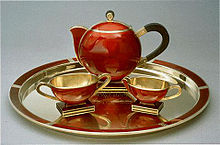Tea set


A tea set, in the Western tradition, is a suite of dishes sold in a group for use at afternoon tea or a formal tea party.
Tea sets vary greatly in quality and price, from inexpensive mass-produced items to high-end, limited edition items. The finest tea sets are made by well-known manufacturers of porcelain or bone china. Another opulent tea set is the silver tea service, a formal tea set with serving pieces made of sterling silver. Mass-produced sets in silverplate are found in more quantity. Because of costs, most holloware (serving pieces) are silverplate rather than sterling.
Items in a tea set
A typical tea set contains the following items:
in addition, a formal tea service would include:
- coffee pot
- kettle with spirit light
- slop bowl or waste bowl
- tray
History
This article includes a list of references, related reading, or external links, but its sources remain unclear because it lacks inline citations. |
The accepted history[1] of the tea set begins in China during the Han Dynasty (206-220 B.C.). At this time, tea ware was made of porcelain and consisted of two styles: a northern white porcelain and a southern light blue porcelain. It is important to understand that these ancient tea sets were not the creamer/sugar bowl companions we know today. Rather, as is stated in a third century A.D. written document from China, tea leaves were pressed into cakes or bricks. These patties were then crushed and mixed with a variety of spices, including orange, ginger, onions, and flower petals. Hot water was poured over the mixture, which was both heated and served in bowls, not teapots. The bowls were multi-purpose, and used for a variety of cooking needs. In this period, evidence suggests that tea was mainly used as a medicinal elixir, not as a daily drink for pleasure's sake.
Historians believe the teapot was developed during the Song Dynasty (960-1279 A.D.) An archaeological dig turned up an ancient kiln that contained the remnants of a Yixing teapot. Yixing teapots, called Zi Sha Hu in China and Purple Sand teapots in the U.S., are perhaps the most famous teapots. They are named for a tiny city located in Jiangsu Province, where a specific compound of iron ore results in the unique coloration of these teapots. They were fired without a glaze and were used to steep specific types of oolong teas. Because of the porous nature of the clay, the teapot would gradually be tempered by using it for brewing one kind of tea. This seasoning was part of the reason to use Yixing teapots. In addition, artisans created fanciful pots incorporating animal shapes.
The Song Dynasty also produced exquisite ceramic teapots and tea bowls in glowing glazes of brown, black, and blue. A bamboo whisk was employed to beat the tea into a frothy confection highly prized by the Chinese.
Chinese YiXing Tea Set
This is a Chinese YiXing tea set used to serve guest which contains the following[2]:
- A YiXing teapot
- A tray to trap the wasted tea/water. Some tea enthusiasts prefer old looking used trays. Therefore they would normally soak the top of the tray with tea for a few days to create the effect. After many uses, the tray will be covered in stains which tea drinkers in China are highly fond of.
- Cups for yourself and guest
- A Tea tool kit which contains the following: digger, funnel, needle, shuffle, tongs and vase.
- A brush to wipe the wasted tea all over the tray to create an even tea stain. Over time, the tray will be covered with beautiful stain patterns.
- A sieve - even if you pour tea from the pot, some tea leaf bits will still be poured out, so a sieve will help to filter out the loose bits during pouring.
- A tea set wouldn’t be completed without arranging a clay animal or two. They are for display and luck. Pour your leftover tea on top of the animals to create some beautiful stain patterns over many uses.
References
- ^ Tea Set History, by Miriam Ellis,2006 http://www.teasetshop.com/teasethistory.shtml
- ^ YiXing Tea Set http://cart.greenteapots.co.uk/index.php?p=page&page_id=making_tea
